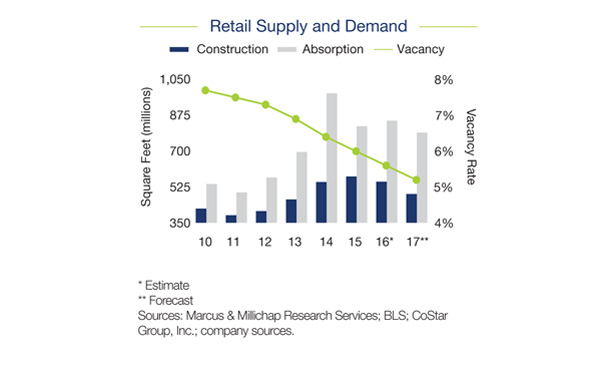CALABASAS, CA—There’s a double dose of good news in Marcus & Millichap’s January Retail Spotlight. First, the sector’s performance was robust during the 2016 holiday shopping season. Second, the retail market is responding to the changing tastes of consumers.
To the first point, the report reveals that the holiday season enjoyed not only a four percentage point gain in November/December year over year, but also outpaced “the 10-year average of 2.5% growth. The recent rise in consumer confidence to the highest level since August 2007 helped fuel the positive results, an indication that consumers feel more secure in their economic circumstances.”
To the second point, it’s no surprise that consumer tastes have been changing, and department stores and malls are among the hardest hit by those shifting wants and needs, and the report cites some specific examples. But, as it reveals, retailers are also responding to those changes
In fact, the Spotlight states that Macy’s is enjoying “double-digit gains in online sales year over year, prompting additional investment in e-commerce and distribution to meet demand.”
Meanwhile, malls and strip centers are rethinking their traditional tenancies to draw in more foot traffic. “The revamped tenant mixes can often generate more revenue through higher prices per square foot from multiple leaseholders and greater customer traffic than previous department stores,” says Marcus & Millichap, “providing a positive outcome for landlords and new choices for consumers.” The paper also cites some of the options in re-thinking that tenant mix, including new bar and restaurant concepts.
Expanding footprints, especially among discount retailers such as Dollar Tree, and re-imagined tenancies have helped the retail sector to drive vacancies down—by 40 bps—and allowed absorption to outpace construction by nearly 30 million square feet in 2016, says the report.
And this year should be no different: “A slower pace of development this year will support similar circumstances, allowing the national vacancy rate to decline by 40 basis points,” the report concludes.
For the full report, please click here.


















 Copyright © 2024 ALM Global, LLC. All Rights Reserved.
Copyright © 2024 ALM Global, LLC. All Rights Reserved.